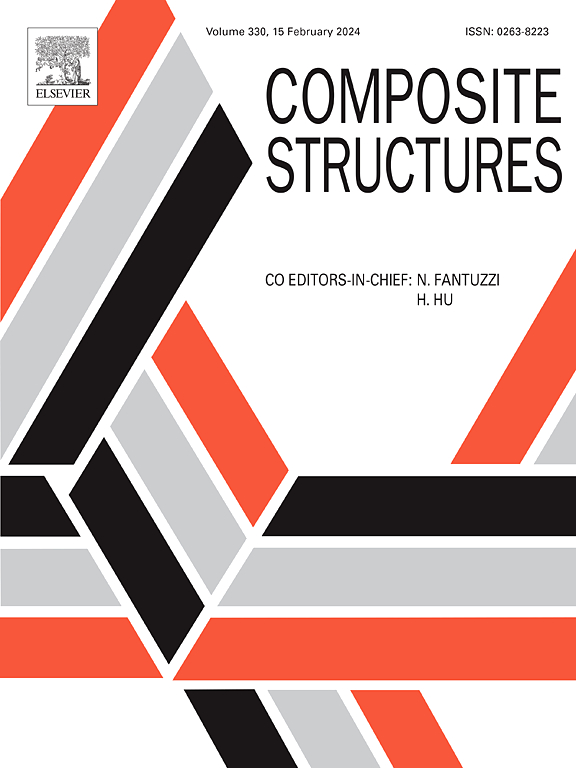Curved grid connector for concrete sandwich shell: a continuum approach
IF 7.1
2区 材料科学
Q1 MATERIALS SCIENCE, COMPOSITES
引用次数: 0
Abstract
Grid connector has been widely used for insulated concrete sandwich panel (ICSP). This paper proposes an innovative curved grid connector for concrete sandwich shell and derives an analytical model using a continuum approach. Firstly, the curved grid is homogenized into a fan-shaped continuum and an equivalent stiffness matrix is obtained, reflecting the constitutive relations of the curved grid in macroscale. Next, the expression of the circumference shear stiffness of the curved grid is derived and verified by Finite Element (FE) models. It can be found that the curved grid connectors have the characteristics of trigonometrically distributed shear stiffness along the circumferential direction . According to the parametric study, the maximum shear stiffness is at the vertex angle of grid members , while becomes constant at and . Additionally, denser arrangement and smaller cross-section of the grid members result in higher stiffness for the same number of connectors. Finally, the bending test of the sandwich shell with a grid connector is presented. The good correlation between the test and analytical results demonstrates the feasibility of applying the analytical model to sandwich shells. The method presented in this paper can be employed for structural optimization and design.
混凝土夹层壳弯曲网格连接器:连续体方法
网格连接器已广泛应用于绝缘混凝土夹芯板(ICSP)。本文提出了一种新型的混凝土夹层壳弯曲网格连接器,并用连续体方法推导了其解析模型。首先,将弯曲网格均质为扇形连续体,得到等效刚度矩阵CH,在宏观尺度上反映了弯曲网格的本构关系;其次,推导了弯曲网格的周向剪切刚度表达式,并通过有限元模型进行了验证。可以发现,弯曲网格连接件具有沿周向φ的三角分布剪切刚度kφ的特性。参数化研究表明,最大抗剪刚度出现在网格顶角β=π/2处,而kφ在β=π/4和β=3π/4处趋于恒定。此外,对于相同数量的连接器,更密集的布置和更小的网格构件的横截面导致更高的刚度。最后,对带网格连接的夹层壳进行了弯曲试验。试验结果与分析结果具有良好的相关性,证明了将分析模型应用于夹层壳的可行性。本文提出的方法可用于结构优化设计。
本文章由计算机程序翻译,如有差异,请以英文原文为准。
求助全文
约1分钟内获得全文
求助全文
来源期刊

Composite Structures
工程技术-材料科学:复合
CiteScore
12.00
自引率
12.70%
发文量
1246
审稿时长
78 days
期刊介绍:
The past few decades have seen outstanding advances in the use of composite materials in structural applications. There can be little doubt that, within engineering circles, composites have revolutionised traditional design concepts and made possible an unparalleled range of new and exciting possibilities as viable materials for construction. Composite Structures, an International Journal, disseminates knowledge between users, manufacturers, designers and researchers involved in structures or structural components manufactured using composite materials.
The journal publishes papers which contribute to knowledge in the use of composite materials in engineering structures. Papers deal with design, research and development studies, experimental investigations, theoretical analysis and fabrication techniques relevant to the application of composites in load-bearing components for assemblies, ranging from individual components such as plates and shells to complete composite structures.
 求助内容:
求助内容: 应助结果提醒方式:
应助结果提醒方式:


